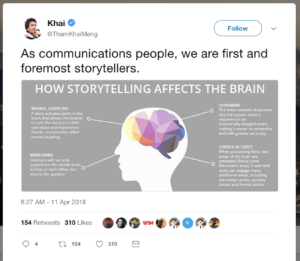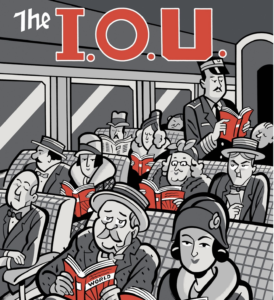Storytelling Through the Lens of F. Scott Fitzgerald
Published on May 14, 2018, at 10:10 a.m.
by Skylar Spencer.
“As communications people, we are first and foremost storytellers,” Tham Khai Meng, Ogilvy co-chairman and worldwide chief creative officer, said in a recent tweet.
Storytelling is a cornerstone of public relations — from crisis to brand identity to reputation management, stories have the power to inform, persuade and elicit responses. But what kind of skills are involved in crafting such a narrative?
What better way to answer this question than to examine the writing techniques of one of the most influential storytellers in the history of American literature, and how those can be translated and used in public relations.
Once Upon A Time …
“The above is not my real name — the fellow it belongs to gave me his permission to sign it to this story. My real name I shall not divulge. I am a publisher. […] All the columnists and communists (I can never get these two words straight) abuse me because they say I want money. I do — I want it terribly.”
 Written nearly 100 years ago, these words belong to F. Scott Fitzgerald and begin “The I.O.U.,” a previously unpublished narrative that now appears in a collection of the author’s lost stories.
Written nearly 100 years ago, these words belong to F. Scott Fitzgerald and begin “The I.O.U.,” a previously unpublished narrative that now appears in a collection of the author’s lost stories.
Any compelling story is driven by a recognizable structure of some sort — a beginning, middle and end — that build on top of the other, contributing to the larger narrative. But what steers this overarching structure?
A defined purpose. What’s the meaning of the story? What kind of story is being told?
Fitzgerald makes “The I.O.U.”’s meaning wittily clear in the narrator’s opening remarks. A story’s purpose or meaning is ineffective, however, if it doesn’t connect with its intended audience.
Identification: Connect the dots
Communicators are on the frontlines of constructing a narrative that resonates. Fitzgerald was notorious for his ability to connect his readers with the story’s central characters … but how?
Consider “The I.O.U”’s plot: The story follows a New York City publisher’s motive to commercialize a veteran’s tragedy into a best-selling novel for the “Great American Public” to consume. This overarching conflict reflected the post-World War I, contemporary culture, and by drawing on a reality that his audience identified with, Fitzgerald established a connection.
The lesson: Identification is a fundamental technique in storytelling. PR practitioners can use similar identification tools — such as empathetic language, explicit references or evoking imagery, symbols, ideas, etc. — when crafting a message that will resonate with an audience.
Form: It’s not what you say, but how you say it
Fitzgerald has been especially praised for his handling of structure and point of view. Consider the narrator’s conclusion in “The I.O.U.”:
“I am a publisher. I publish any sort of book. I am looking for a book that will sell five hundred thousand copies. This is the season for novels with a psychic turn. If possible I would prefer something by a fervent materialist about a wealthy clubman and a dark apachess — or something about love. Love is a sure thing — it takes a living man to love.”
It’s not what he’s saying that draws the reader in — it’s how he says it. Fitzgerald’s writing is saturated with diction, similes, syntax and rhetorical strategies to convey his message in a way that provokes an emotional response.
His use of a partially involved narrator and multiple viewpoints increases the readers’ belief in and sympathy for his characters. A recent Ketchum blog titled “Harnessing the Power of ’I’” noted a related point:
“A first-person narrator creates a sense of intimacy. We identify with the narrator and imagine ourselves in the story. You feel as if you are there, walking with the narrator. You see the world through their eyes. Thoughts, fears, opinions, and biases are palpable.”
So, what makes Fitzgerald’s writing so effective?
A remarkable fusion of technique and style with identifiable material, and thus, a distinctive personal voice.
… The End




